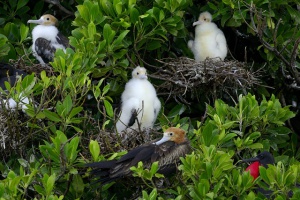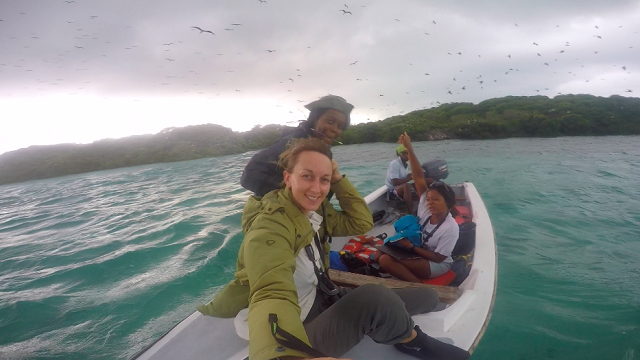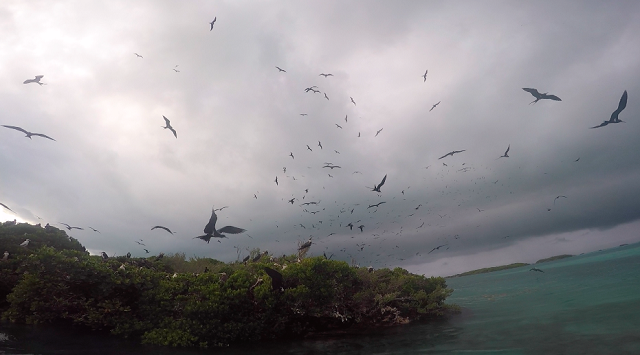Seychellois conservationists on Aldabra conclude annual count of one of world’s largest colonies of frigatebirds
Conservation |Author: Hajira Amla and Sharon Uranie | June 13, 2016, Monday @ 15:30| 9434 views
A frigatebird colony on Aldabra. (Seychelles Island Foundation)
(Seychelles News Agency) - They might be one of the most populous species of seabird in the world, but in Seychelles an annual count is considered a vital tool in understanding the population dynamics of the frigatebirds. Conservationists have recently completed the sixth annual survey to count the number of frigatebirds at their breeding spot on one of the most remote islands of this Indian Ocean archipelago.
Aggressive in hunting but yet sensitive to disturbance, the frigatebirds breed in one of the most isolated and wild locations in the world - the UNESCO Heritage Site of Aldabra. The remote coral atoll is located some 1,100 kilometres away from the main Seychelles island, Mahé.
But just how do you go about counting thousands of moving sea birds? This is the challenge faced by staff every year at the Seychelles Islands Foundation (SIF), the public trust which manages the Aldabra atoll.
April Burt, Aldabra’s Scientific Coordinator, who took on the task this year with a small team of rangers, admits counting the birds is not for the faint-hearted.
“The sheer size of Aldabra ensures that any form of population surveys are very challenging,” she said in an interview with SNA. “To put it in perspective, the island of Mahé could fit inside the Aldabra lagoon.”
However, counting only the breeding pairs and not individual birds makes it slightly easier, in addition to the fact that the birds nest in four specific breeding colonies, meaning the survey team knows which areas in which to look for them each year.
 |
| The survey team carrying out the annual count of the seabirds on Aldabra a remote coral atoll located some 1,100 kilometres from the Seychelles main island, Mahe. (Seychelles Island Foundation) Photo License: All Rights Reserved |
Although the annual data for this year's survey is still being processed, it is estimated that there are at least 11,000 pairs on the atoll (4,400 great and 6,600 lesser frigatebirds), based on a 2011 paper published in the journal Bird Conservation International.
Burt says the consistent collection of this data over years is one of the most valuable tools in conservation biology, allowing researchers to access long-term data about the birds’ numbers and whether their colonies move over time.
Seabirds are also recognised as important regional and global indicators of the functioning of the marine food chain system.
“Frigatebirds feed on flying fish and squid associated with sub-surface predators, such as tuna,” Burt explained.
“Population fluctuations may be linked to food availability or lack thereof when factoring in tuna fishing within the region. Monitoring of key seabird populations such as Aldabra's frigatebird colonies, and subsequent conservation measures, are therefore critical components of Marine Protected Area management.”
The pirates of the Indian Ocean
The frigatebird, with its aerodynamically-shaped wings and distinctive black plumage, can often be found attacking other seabirds to make them regurgitate and drop their fish catch. The frigatebird then swoops down and steals the food to take back to their own chicks.
The gentle red-footed booby seabird, which can also be found in large numbers throughout the Aldabra atoll, are often the victims of this behaviour.
Frigatebirds are known to favour tropical climates, with their distribution spread from the western Indian Ocean eastwards along the equatorial line right through to the Pacific Ocean, reaching as far as Hawaii.
Despite their propensity for migration and seeking out new fishing grounds, frigatebirds tend to return back to the same colonies they hatched from to breed.
 |
| Counting only the breeding pairs and not individual birds is said to make the task of counting the frigatebirds easier. (Seychelles Island Foundation) Photo License: All Rights Reserved |
Sensitive breeding cycles
Although the surveys have been carried out for six years, Burt says it is still too early to draw finite conclusions on the colonies’ population dynamics, as the birds do not have a regular breeding cycle.
“Factors such as food availability and competition influence individual fitness and there is also annual mortality and recruitment into the breeding population which can increase or decrease the annual breeding population,” she told SNA.
Highly sensitive to disturbance, the presence of humans is one of the biggest risk factors to their success during breeding, so researchers must tread carefully when studying the birds.
“The brooding parents readily take flight when disturbed, usually resulting in the loss of the egg as the nest is immediately plundered by a male looking for a display site or nesting material,” Burt said.
“We are extremely cautious when carrying out the surveys, which are times when there is the least egg brooding to minimise disturbance. We also keep as much distance as possible from the colonies and minimise noise or fast movements of the boat.”
Because it takes between 12 to 19 months from the laying of an egg until a chick becomes a fledgeling, adults do not breed annually; however, seasonal peaks in breeding activity have been recorded on Aldabra, with the main laying period falling between June and September for lesser and August to October for greater frigatebirds.
SIF has strict regulations associated with visiting the frigate colony areas, especially when it comes to tourist visits to Aldabra, so the researchers and rangers working on this beautiful and wild atoll feel extremely fortunate to have the opportunity to get up close and personal with these majestic seabirds.
“It is a great pleasure and privilege to get to experience frigatebirds up close, whether in flight or during nesting. They are extremely impressive birds and a part of the Aldabra story,” said Burt.
Back
